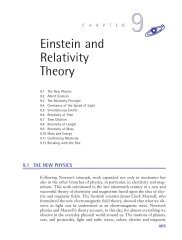Chapter 12: Electromagnetic Waves (545 KB) - D Cassidy Books
Chapter 12: Electromagnetic Waves (545 KB) - D Cassidy Books
Chapter 12: Electromagnetic Waves (545 KB) - D Cassidy Books
Create successful ePaper yourself
Turn your PDF publications into a flip-book with our unique Google optimized e-Paper software.
3637_<strong>Cassidy</strong>TX_<strong>12</strong> 6/13/02 11:34 AM Page 572572 <strong>12</strong>. ELECTROMAGNETIC WAVESThe environmental and technological problem ofIn an actual greenhouse, thelargest contribution to keep the the phenomenon of global warming is associated withinterior heated is the reduction infrared radiation. Since the Earth is warmed by theof convection, which is the same Sun, the surface of the Earth also emits infrared radiation.Much of this radiation is dissipated intoprinciple as used for wine-coolerjackets.outer space, but some of it is naturally trapped bywater vapor in the atmosphere. Like a blanket, thewater vapor in the air reflects many of the infrared rays back to the Earth’ssurface, thus keeping the Earth’s surface at just the right temperature forlife to exist. This is known as the greenhouse effect, since greenhouses operatein the same way. The glass walls and roof of the greenhouse allow theSun’s visible rays to pass through, but they prevent the invisible infraredrays from escaping, thus warming the inside of the greenhouse where plantscan grow year round. (You encounter the same effect when you leave thewindows rolled up in a car parked in the sun.)It has now been substantiated by scientists, including the U.S. NationalAcademy of Sciences, that since the advent of the Industrial Revolution,much more of the infrared radiation emitted back into space by the Earth’ssurface is becoming trapped in the atmosphere by the gases producedthrough the burning of fossil fuels that run electric generators and transportationvehicles. The burning of these fuels produces carbon dioxide, sulfurdioxide, water vapor, and other gases and small particles. These gasesallow the Sun’s visible and ultraviolet rays to reach the ground, but reflectthe infrared radiation emitted by the Earth’s surface back to the Earth,keeping the infrared rays trapped in the atmosphere and thus causing globalwarming. (These gases also cause acid rain.)This enhanced greenhouse effect accounts for an average rise in theEarth’s temperature during the past century of only a degree or two Celsius,but scientists using computer models predict that this increase doeshave a major impact on the ecology on Earth, causing at different locationsincreased drought or rainfall, more powerful storms, and crop failures. Theypoint to the fact that the average temperature of Earth during the last IceAge was only about 5°C cooler than it is now. The unusual melting of glaciersand polar ice, the unusually warm winters and summers in recentdecades, and the unusually large rainfalls and flooding around the worldare signs of even more trouble ahead unless the burning of fossil fuels iscurtailed.During the 1990s a series of international meetings occurred in order tofind a way to reduce the emission of “greenhouse gases.” Unfortunately,the nations of the world could not agree because of economic reasons. Thedeveloping nations do not want to limit their growth, especially after thedeveloped nations had already achieved their growth without limiting their






